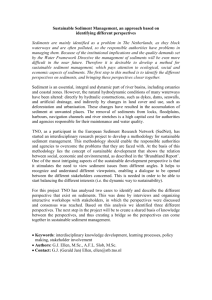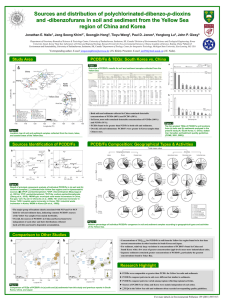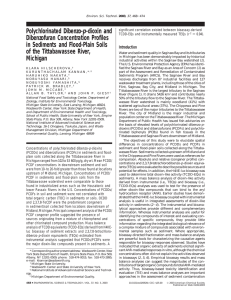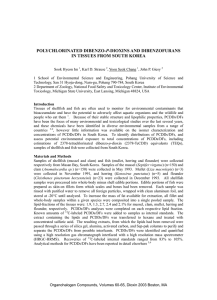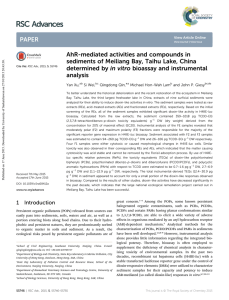ECOTOXICOLOGY MASS BALANCE APPROACHES TO DIOXIN EXPOSURES IN A MICHIGAN RIVER, USA
advertisement
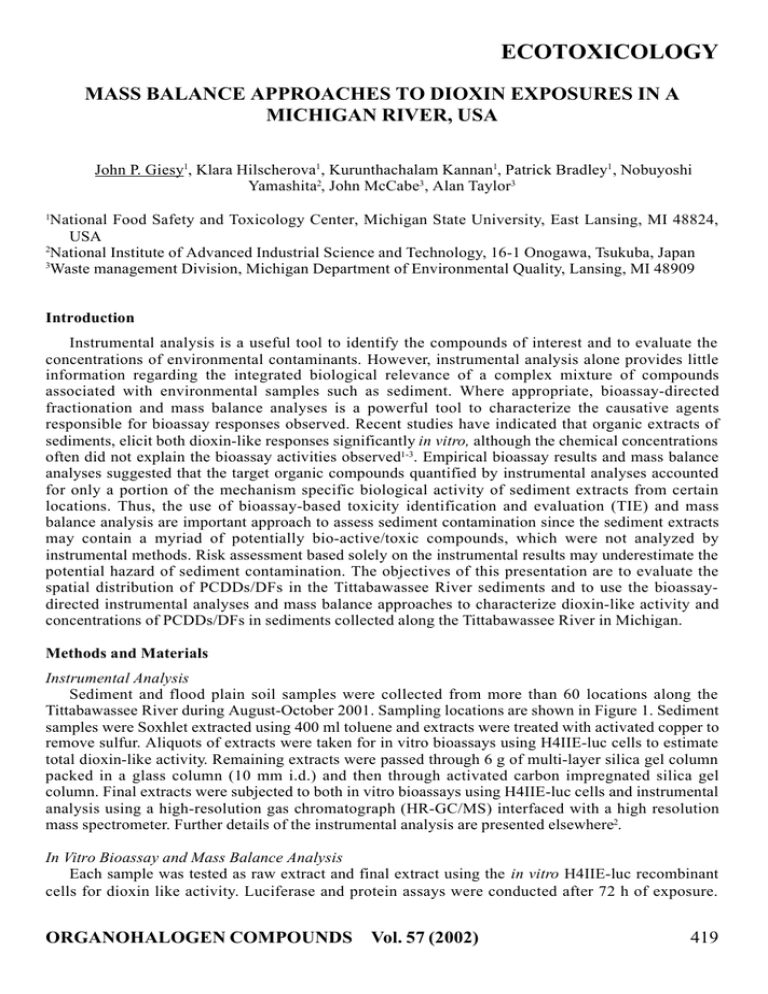
ECOTOXICOLOGY MASS BALANCE APPROACHES TO DIOXIN EXPOSURES IN A MICHIGAN RIVER, USA John P. Giesy1, Klara Hilscherova1, Kurunthachalam Kannan1, Patrick Bradley1, Nobuyoshi Yamashita2, John McCabe3, Alan Taylor3 1 National Food Safety and Toxicology Center, Michigan State University, East Lansing, MI 48824, USA 2 National Institute of Advanced Industrial Science and Technology, 16-1 Onogawa, Tsukuba, Japan 3 Waste management Division, Michigan Department of Environmental Quality, Lansing, MI 48909 Introduction Instrumental analysis is a useful tool to identify the compounds of interest and to evaluate the concentrations of environmental contaminants. However, instrumental analysis alone provides little information regarding the integrated biological relevance of a complex mixture of compounds associated with environmental samples such as sediment. Where appropriate, bioassay-directed fractionation and mass balance analyses is a powerful tool to characterize the causative agents responsible for bioassay responses observed. Recent studies have indicated that organic extracts of sediments, elicit both dioxin-like responses significantly in vitro, although the chemical concentrations often did not explain the bioassay activities observed1-3. Empirical bioassay results and mass balance analyses suggested that the target organic compounds quantified by instrumental analyses accounted for only a portion of the mechanism specific biological activity of sediment extracts from certain locations. Thus, the use of bioassay-based toxicity identification and evaluation (TIE) and mass balance analysis are important approach to assess sediment contamination since the sediment extracts may contain a myriad of potentially bio-active/toxic compounds, which were not analyzed by instrumental methods. Risk assessment based solely on the instrumental results may underestimate the potential hazard of sediment contamination. The objectives of this presentation are to evaluate the spatial distribution of PCDDs/DFs in the Tittabawassee River sediments and to use the bioassaydirected instrumental analyses and mass balance approaches to characterize dioxin-like activity and concentrations of PCDDs/DFs in sediments collected along the Tittabawassee River in Michigan. Methods and Materials Instrumental Analysis Sediment and flood plain soil samples were collected from more than 60 locations along the Tittabawassee River during August-October 2001. Sampling locations are shown in Figure 1. Sediment samples were Soxhlet extracted using 400 ml toluene and extracts were treated with activated copper to remove sulfur. Aliquots of extracts were taken for in vitro bioassays using H4IIE-luc cells to estimate total dioxin-like activity. Remaining extracts were passed through 6 g of multi-layer silica gel column packed in a glass column (10 mm i.d.) and then through activated carbon impregnated silica gel column. Final extracts were subjected to both in vitro bioassays using H4IIE-luc cells and instrumental analysis using a high-resolution gas chromatograph (HR-GC/MS) interfaced with a high resolution mass spectrometer. Further details of the instrumental analysis are presented elsewhere2. In Vitro Bioassay and Mass Balance Analysis Each sample was tested as raw extract and final extract using the in vitro H4IIE-luc recombinant cells for dioxin like activity. Luciferase and protein assays were conducted after 72 h of exposure. ORGANOHALOGEN COMPOUNDS Vol. 57 (2002) 419 ECOTOXICOLOGY Figure 1. Map of Tittabawassee River watershed in Michigan, USA, showing sampling locations. Sample responses, expressed as mean RLU over three replicate wells, were converted to relative response units, expressed as a percentage of the maximum response observed for 2,3,7,8tetrachlorodibenzo-p-dioxin (TCDD; %-TCDD-max.) standard curves generated on the same day. Where appropriate, sample potency relative to the TCDD, was estimated. Mass balance analysis (or potency balance analysis) used to examine whether or not the known composition of a sample (identified by instrumental analysis) can account for the magnitude or potency of biological response observed. Two type of mass balance analysis (potency-based and magnitude based) was applied to aid in discussion and hypothesis generation regarding the probable causes of dioxin-like activity associated with samples. Further details of the bioassay procedures and mass balance analysis are presented elsewhere1,3. Results and Discussion Mean concentration of 17 2,3,7,8-substituted PCDD and PCDF congeners along the Tittabawassee River basin was 8020 pg/g, dry wt. The residue concentrations of total PCDDs/DFs varied by three orders of magnitude from 44 to 53600 pg/g on a dry weight basis. The greatest concentration was found in a flood plain soil located at the middle portion of the river. Two sediment samples collected upstream of the Tittabawssee River in Chippewa and Pine River locations contained total PCDD and PCDF concentrations 470 and 510 pg/g, dry wt, respectively. Concentrations of total PCDDs and PCDFs in Tittabawassee sediment samples are greater than those reported for Housatonic River sediments, which varied from 160 to 5,400 pg/g dry wt, except in one sample that contained a concentration of 82,000 420 ORGANOHALOGEN COMPOUNDS Vol. 57 (2002) ECOTOXICOLOGY pg/g, dry wt4. Total concentrations of PCDDs/DFs in sediments from the United Kingdom rivers ranged from 446 to 9,310 pg/g, dry wt, in Korea from 102 to 6490 pg/g, dry wt and in Japan ranged from 377 to 15,800 pg/g, dry wt 5,7 . No apparent spatial gradient in PCDD/DF concentrations was evident although the mid-sections of the sampling locations in the river contained greater concentrations. The differences in concentrations could be explained hydrological and geological characteristics of the river. Concentrations of total PCDDs/DFs were significantly correlated with organic carbon content (p<0.05; r=0.45) Concentrations of PCDFs were greater than those of PCDDs in 29 of the 61 sediment/soil samples analyzed. Mean concentrations of PCDD and PCDF were 3740 and 4280 pg/g, dry wt, respectively. Sediments taken from Pine and Chippewa Rivers contained 6 to 16-fold greater concentrations of PCDDs compared to those of PCDFs. Among PCDF congeners, 2,3,7,8-TCDF was the most abundant congeners in sediment/soil from several locations. OCDD was the major congener among PCDDs. The average profile of PCDD and PCDF congeners in sediment and soil is presented (Figure 2). Figure 2. Relative composition (%) of PCDD and PCDF congeners in soil and sediments collected along the Tittabawassee River, Michigan. Different sources of PCDDs/DFs are characterized by different congener and homologue patterns. Furthermore, differences in the physicochemical (mobility, solubility, etc.) and biological (biodegradation, bioaccumulation, etc.) properties may alter the congener profiles. The profile of PCDD and PCDF congeners in sediment and soil from Tittabawassee River watershed remained almost uniform in most locations suggesting the presence of a major source. A high percentage of OCDD and HpCDD has been suggested to be due to the sources originating from pentachlorophenol and chlorophenoxy acids manufacturing. Greater proportions of TCDFs suggest sources originating from PCB mixtures. However, total PCBs concentrations in sediments from the Tittabawassee River were less than 0.5 ng/g, dry wt (Michigan Department of Environmental Quality, 2002, suggesting that the contribution of technical PCBs to PCDF contamination in sediments is negligible. Chlor-alkali processes have been shown to contribute greater proportion of HpCDF and OCDF8. The 2,3,7,8-tetrachlorodibenzo-p-dioxin equivalents (TEQs) were estimated using H4IIE cell line specific toxic equivalency factors (TEF)9. This was necessary to perform mass balance analysis of TCDD-Eqs derived using H4IIE cell bioassays for the sediment and soil extracts. Concentrations of TEQs in sediments and soils from the Tittabawassee River watershed ranged from 1.4 to 3220 pg/g, dry ORGANOHALOGEN COMPOUNDS Vol. 57 (2002) 421 ECOTOXICOLOGY wt (mean: 780 pg/g, dry wt). Despite OCDF was assigned a TEF of zero, PCDFs were the major contributors to TEQs accounting for, on average, 98 % of the total TEQs. Among PCDFs, 2,3,7,8TCDF was the major contributor to TEQs in sediments followed in order by 1,2,3,7,8-PeCDf and 1,2,3,6,7,8-HxCDF and 2,3,4,7,8-PeCDF. These four congeners collectively accounted for 90 % of the total TEQs. There was a significant correlation between TCDD-Eqs derived from H4IIE-luc bioassay and TEQs estimated from instrumental analysis (Figure 3). Mass balance analysis suggested that PCDDs/DFs contributed to a considerable portion of the TEQs in sediments/soils. Figure 3. Relationship between instrumental and bioassay analysis of sediment dioxin-like activities Acknowledgement We thank Michigan Department of Environmental Quality for technical support and Great Lakes Protection Fund for funding this study. References 1. Khim J.S., Villeneuve D.L., Kannan K., Koh C.H., and Giesy J.P. (1999). Environ Sci Technol 33:4199-4205. 2. Kannan, K., Villeneuve, D.L., Yamashita, N., Imagawa, T., Hashimoto, S., Miyazaki, A. and Giesy, J.P. (2000). Environ. Sci. Technol. 34, 3560-3567. 3. Hilscherova, K., Kannan, K., Kang, Y-S., Holoubek, I., Machala, M., Masunaga, S., Nakanishi, J. and Giesy, J.P. (2001). Environ. Toxicol. Chem. 20, 2768-2777. 4. Eitzer, B.D. (1993). Environ. Sci. Technol. 27, 1632-1637. 5. Rose, C.L., McKay, W.A. and Ambidge, P.F. (1994). Chemosphere 29, 1279-1292. 6. Im, S.H., Kannan, K., Matsuda, M., Giesy, J.P. and Wakimoto, T. (2002). Environ. Toxicol. Chem., 21, 245-252. 7. Sakurai, T., Kim, J.G., Suzuki, N. and Nakanishi, J. (1996). Chemosphere, 33, 2007-2020. 8. Kannan, K., Watanabe, I. and Giesy, J.P. (1998). Toxicol. Environ. Chem., 67, 135-146. 9. Giesy, J.P.; Jude, D.J.; Tillitt, D.E.; Gale, R.W.; Meadows, J.C.; Zajieck, J.L.; Peterman, P.H.; Verbrugge, D.A.; Sanderson, J.T.; Schwartz, T.R.; Tuchman, M.L. (1997). Environ. Toxicol. Chem. 16, 713-724. 422 ORGANOHALOGEN COMPOUNDS Vol. 57 (2002)





